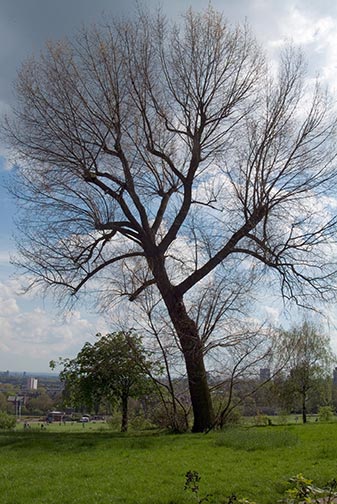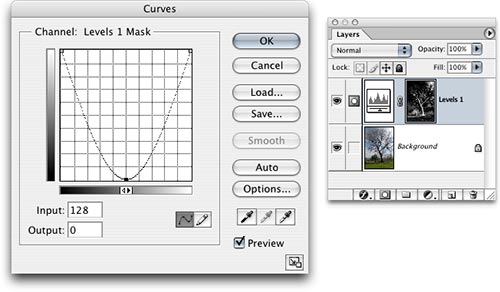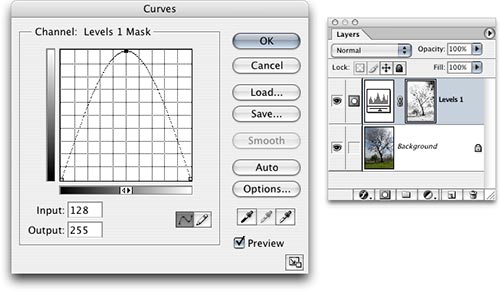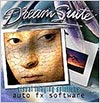



Creating And Saving Selection Masks
From the ExtremeTech book, Hacking Photoshop CS2 by Shangara Singh, published by John Wiley and Sons. (Reprinted with permission.)
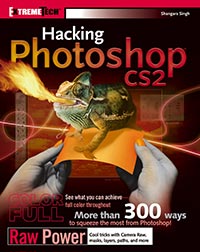 Selections can be created in a number of ways. They can be created from the ground up using the selection marquee or lasso tools, or with painting tools by entering Quick Mask mode, or they can be based on the luminosity or the color data in the image. They can also be created from existing paths and path components. In ImageReady, you can create selections from slices. Selections can be created in a number of ways. They can be created from the ground up using the selection marquee or lasso tools, or with painting tools by entering Quick Mask mode, or they can be based on the luminosity or the color data in the image. They can also be created from existing paths and path components. In ImageReady, you can create selections from slices.
To prevent an oval- or irregular-shaped selection from viewing and printing with a stair-stepping effect, you can create selections with feathering or anti-aliasing so that they lack hard edges, and select content gradually inward and outward from the selection boundary. The feathering can be specified before the selection is created or after the event; however, the anti-aliasing has to be specified before an oval or irregular selection is created.
Selections can be contiguous or non-contiguous. You can add to or subtract from existing selections and draw freehand or in straight lines and even horizontal or vertical lines. After a selection is created, you can hide it temporarily so that you can see the image that you are working on without being distracted by the animated selection outlines.
Selections are temporary by default but can be stored as grayscale images in alpha channels, loaded from the alpha channel at any time, or exported to another open document.
Note: Remember, not all file formats support alpha channels; the most popular file formats, PSD, PDF, TIFF, BMP, Targa, and Pixar do, but another very popular format, JPEG, does not.
Creating Circles and Squares Using Marquee Tools
You can create rectangular and elliptical selections easily in Photoshop by using the Rectangular Marquee or the Elliptical Marquee tools (M), respectively. However, odd as the omission might seem, Photoshop does not include dedicated selection tools for creating round, square, or round-cornered selections. The absence of such tools often throws off novice users. Therefore, the following hack is just for you if you happen to belong to such a group.
You have two ways of making a round or square selection. You can use the selection tools or the shape tools. Using the selection tools, take the following steps:
- Select the Elliptical or the Rectangular Marquee tool from the Toolbox.
- Press the Shift key. This action constrains the marquee to a circle or a square, depending on the active tool.
- Click in the document window and drag to form a round or square marquee, respectively.
For the second method, using the shape tools, take the following steps:
- Select the Rectangle or the Ellipse Shape tool (U).
- Select the Paths option for the tool from the options bar (it’s the second icon from the left, barring the tool icon).
- Press the Shift key. Doing so constrains the path to a circle or square, depending on the active tool.
- Click in the document window and drag to form a round or square path, respectively.
- Hold down Ctrl (Windows), cmd (Mac OS) and press Enter (Windows), Return (Mac OS) to create a selection from the path, or choose Make Selection from the Paths palette menu and have access to extra options.
At first sight, it can seem labor intensive to create a selection from a path. However, with a little practice, you can go through the steps without thinking.
Tip: To create rectangular or square selections with rounded corners in Photoshop, use the Rectangle Shape tool to draw a path and then create a selection from it (see step 5 in the preceding numbered list).
Color-Based Masks
The ability to make selections based on a particular color or hue can be very useful at times. For example, maybe you need to adjust or change the color of someone’s red shirt or blue jeans. You can do this by using the Magic Wand tool, but Photoshop includes a command that gives you more control over what is selected and what is not, as well as the ability to select highlights, midtones, shadows, and out-of-gamut colors. The command can be found in the Select menu and goes by the name Color Range (Figure 9-1).
The Fuzziness setting in Color Range works in a slightly different way from how the Tolerance setting for the Magic Wand tool determines which pixels should be added to the selection. Whereas Tolerance determines the range of fully selected pixels, Fuzziness also determines the range of partially selected pixels. In other words, you can create more subtle masks with the Color Range command than you can with the Magic Wand tool, which is very good at selecting broad ranges of color.
When you enter the Color Range dialog box, a selection is made for you based on the foreground color. If you would rather start with a blank slate, press Alt (Windows), Opt (Mac OS) before you select the command. You can also limit the selection to a specific area by making a selection before you enter the Color Range dialog box.
In the dialog box, you can add or subtract from the selection by using the eyedropper tools. The sample tool is selected by default, and you can drag it in the document window to define the selection range. Rather than switch tools by clicking the icons, you can press Shift to add and Alt (Windows), Opt (Mac OS) to subtract from the selection range.
You can also use the eyedropper tools in the proxy window by selecting the Image button, next to the Selection button. The proxy window always shows a 100% magnification, and this can be useful if the complete image isn’t in view in the document window (though you can still use the options under the View menu and the related shortcuts to change the document magnification). Furthermore, you can choose from four types of previews, not including None, from the Selection Preview pop-up at the bottom of the dialog box.
In addition to using the eyedropper tools to define a selection range, you can choose from preset colors in the Select pop-up menu at the top of the dialog box. Note that The Out of Gamut range is based on the CMYK working space defined in Edit > Color Settings. When you leave the dialog box, the selection is applied for you.
Tip: To toggle between the Image and Selection previews, press Ctrl (Windows), cmd (Mac OS).
Luminosity-Based Masks
Selections based on the luminosity values contained in an image can be created from the composite or default color channels. They can be used to protect a range of levels from highlight to shadow when you apply adjustments and, with a bit of work, clamped to mask changes to extreme highlights, shadows, or midtones when you use them in adjustment layer masks.
You can base the mask on the composite channel by pressing Ctrl+Alt+Tilde (Windows), cmd+Opt+Tilde (Mac OS), or on the individual channels, including the composite, by Ctrl-clicking (Windows), cmd-clicking (Mac OS).
You can also convert a duplicate to Grayscale mode and use its single channel to load the selection, or to Lab mode and use the L channel, or to CMYK mode and use the K channel (each produces a slightly different mask).
After the selection is loaded, you can import it into the parent document. To do so, choose a selection tool, click in the selected area (the icon should change to a white arrow with an accompanying rectangular selection outline when you are over the selected area), and then drag the selection into the parent document. Hold down the Shift key when the mask is over the target window to center the selection.
Having loaded the selection, you can use the adjustment commands, such as Curves or Hue/Saturation, directly on a layer or create an adjustment layer and have the mask applied automatically.
By default, the highlights are selected and the shadows masked. You can easily inverse the selection by choosing Select > Inverse, or Ctrl+Shift+I (Windows), cmd+Shift+I (Mac OS).
To clamp or restrict the luminosity mask, save it as an alpha channel and then apply a curve that basically clips the highlight, midtone, or shadow values Likewise, if the luminosity mask was loaded in an adjustment layer mask, target the mask and then use Curves to restrict the adjustment’s influence on the layer content (Figure 9-2).
Channel-Based Masks
When you’re creating a selection, channels are often good candidates for the basis of a mask, and in some images, one might yield a mask without much work. For example, you might have an image of a red building against a blue sky. By finding the channel that contains the strongest contrast between the red and blue, you can create a copy of the channel, increase the contrast and "discover" a mask (Figure 9-3). To view individual channels, click each one in turn in the Channels palette. It helps to view them as grayscale when evaluating channel content. If you are seeing them in color, choose Preferences > Display & Cursors and deselect the option Color Channels in Color. When you find a likely candidate for a mask, create a copy by dragging it to the Create New Channel button, located next to the Trash in the Channels palette.
The copied channel might need a little bit of work to perfect the mask, which you can do easily with the Brush tool by painting with black or white (see "Using Painting Tools and Filters," later in the chapter). When you are happy with the mask, Ctrl-click (Windows), cmd-click (Mac OS) to load it as a selection.
In addition to the Brush tool, you can use the Dodge and Burn tools on the channel to lighten or to darken detail around the mask’s edges. To do so, select the corresponding range on the options bar (Shadows, Midtones, or Highlights) and then apply to remove unwanted detail. This way, you can preserve the mask edge while sending unwanted detail on either side of the edge to black or to white. This technique is particularly useful when you’re creating masks with irregular edges, such as hair.
Tip: You can use keyboard shortcuts to switch between the ranges for the Dodge and Burn tools. Shadows: Alt+Shift+S (Windows), Opt+Shift+S (Mac OS); Midtones: Alt+Shift+M (Windows), Opt+Shift+M (Mac OS); Highlights: Alt+Shift+H (Windows), Opt+Shift+H (Mac OS). You can also temporarily switch between the tools by holding down Alt (Windows), Opt (Mac OS).
Defining a Selection from an Exact Center Point
When you use the marquee tools to define a selection, the starting point is always the top-left corner of a rectangular selection or, in the case of an elliptical selection, an imaginary rectangular box. This can be problematic if what you want to do is to center the selection on an exact center point. For example, having drawn a circular object, you might want the selection to center on the epicenter of the object in order to adjust it. The workaround is to define the epicenter of the object, or of the first selection if you intend to overlap two selections, by using guides and then draw outward from the epicenter.
To find the epicenter of an existing object, take the following steps:
- Activate the layer for the object.
- Press Ctrl+T (Windows), cmd+T (Mac OS) to activate the object’s bounding box. Alternatively, select the Move tool (M) and select Show Transform Controls on the options bar.
- Make sure that rulers are showing (View > Rulers) and then drag from the ruler to create a guide and let it snap to the fulcrum icon; do the same from both rulers. You should now have a cross over the epicenter of the object.
- Press Esc if you used the transform command in step 2.
- Having defined the epicenter, choose a selection tool (it helps to have Other Cursors in Preferences > Display and Cursors set to Precise for the next step).
- Hover over the cross formed by the guides and position the pointer on the epicenter; use the change in color of the tool icon to guide you to the epicenter.
- Hold down Alt (Windows), Opt (Mac OS) and draw outward.
You don’t need to press Alt (Windows), Opt (Mac OS) before you start to define the marquee; you can do it at anytime during the operation, as long as you have not lifted the pointer off the document.
Defining an Aspect Ratio for a Selection
The Rectangular and the Elliptical Marquee tools have some options that are often overlooked. You can preset their width and height to a fixed size or define a width-to-height ratio. For example, if you want to create a marquee that’s three times as wide as it is high, click the Style pop-up menu in the options bar (Figure 9-4), select Fixed Aspect Ratio, and then enter 3 in the Width text field and 1 in the Height text field. Now, when you drag with the marquee tool, your selection will be three times as wide as it is high.
If you need to crop an image by a given number of pixels using the Crop command, as opposed to the Crop tool, you can define the marquee from the same Style pop-up menu. Just select Fixed Size and then enter the pixel dimensions. You can set the width and height in any of the supported units (pixels, inches, cm, mm, points, picas, and percent).
When you enter values in text fields on the options bar, you can right-click (Windows), Ctrl-click (Mac OS) in the box and choose from the supported units in the pop-up menu. Furthermore, you are not restricted to whole numbers but can use fractions. For example, you can choose an aspect ratio for 1.85 to 1.
If you use a particular fixed size or aspect ratio repeatedly, save it as a tool preset by clicking the tool icon on the options bar and then choosing New Tool Preset from the pop-up Tool Preset Picker menu; give it a memorable name for easier identification.
Irregular Selections
One way to create irregular selections is by using the lasso tools. The other way, less intuitive but more exciting, is to use filters. Although you cannot define a selection with a filter, you can modify it (Figure 9-5). Try the following:
- Create a new document.
- Create a selection with the Rectangular Marquee tool.
- Choose Select > Modify > Border and enter a value that looks good for the marquee size.
- Press Q to enter Quick Mask Mode.
- Choose Filter > Distort > Wave and play with the settings.
- Exit the Wave dialog box and then press Q to exit Quick Mask mode.
- Create a new layer and fill the selection with a color.
Try other filters on differently shaped selections. Also, try reapplying the filters or stacking filter effects using a combination of filters. You can do that in the Filter Gallery dialog box (Filter > Filter Gallery) by clicking the New Effect Layer icon, located at the bottom of the window, and then applying another filter.
Selection from a Work Path
Using paths to create selections opens a number of options. Should you need to make a selection with rounded corners, you can use the Ellipse Shape tool to define a path and then load it as a selection. You can also use the Pen tool to create a very precise path and then load that as a selection. Furthermore, you can load path components as selections.
To create a selection from a work path, take the following step:
- Draw a path with the pen or shape tools (if it’s a complex path, remember to save it from the Paths palette menu).
- Hold down Ctrl (Windows) and press Enter, or hold down cmd and press Return (Mac OS). You can also click the Load Path as a Selection button in the Paths palette (located third from left).
To create a selection from a path component, select it with the Path Selection tool (A) and then click the Load Path as a Selection button in the Paths palette. The keyboard shortcut to load a path as a selection will not work in this case because it will load the entire path.
Tip: The converse to creating a selection from a path is also possible. To create a path from a selection, select Create Work Path from the Paths palette menu and enter a tolerance value between 0.5 and 10. The lower the value, the more accurately the path will follow the selection edges.
Feathered Selections
When you use a selection to make compilations of images, extract elements from their background, apply edits, or make tonal adjustments, feathering can help to blend the object being worked upon into the background by creating a soft edge around the selection edge. The soft edge is not unlike the anti-aliasing applied to elliptical and irregular selections. However, it differs in one respect. It extends inward and outward from the selection edge, whereas anti-aliasing creates a soft transitional zone only on the inside of the selection edge (Figure 9-6).
You can apply feathering before you create the selection by specifying it in the options bar or after the event by choosing Select > Feather, or Ctrl+Alt+D (Windows), cmd+Opt+D (Mac OS).
One popular use of feathering involves the use of an elliptical, feathered selection to create a vignette (Figure 9-7). The following steps will create a vignette and add a new background and watermarks around the vignette.
- Make sure that the image is on a normal layer and not a Background layer.
- Select the Elliptical Marquee tool and enter a value in the Feather text box. The figure that you enter will, of course, depend on the pixel dimensions of the image and size of the soft edge you desire.
- Make the selection and then choose Select > Inverse. Doing so masks the areas that you want to conserve and exposes the peripheral areas.
- Press Backspace (Windows), Delete (Mac OS) to delete the peripheral areas.
- Add a new layer below the image layer and fill it with a solid color of your choice.
- Finally, to add strokes around the vignette, create a new layer above the image layer and apply strokes to rectangular or elliptical selections.
Feathering, though essential, can be notoriously difficult to see, making it difficult to judge which parts of the image will be affected or, indeed, how much feathering you should apply in the first place. This is because the marquee shows only the parts of the mask that are 50% or more opaque. To have a more precise idea of how the feathering tapers off, take the following steps:
- Create a selection and apply feathering (see preceding paragraphs).
- Press Q to enter into Quick Mask mode.
You should be able to see how the selection tapers off. If you still cannot see it too well, double-click the Quick Mask icon below the color boxes in the Toolbox and then change the opacity to 100%.
Photoshop includes one other method for applying feathering. The end result differs slightly from the feathering applied via the Select menu or the options for the marquee tools. To take advantage of it, after creating the selection, enter Quick Mask mode and then apply Filter > Blur > Gaussian Blur. You can also apply the other blur filters to vary the effect or to create special effects. For example, if you are making compilations, rather than settle for just a soft edge, try a Shape Blur (Figure 9-8).
Saving a Selection with a File
Regardless of the method you use to create a selection, they are temporary affairs and can disappear altogether if Photoshop quits for some reason or you have a system freeze and have to shut down. To avoid having to recreate a selection that you have spent hours creating, you can convert it to an alpha channel and save it in the file. You then have the option of loading the selection at any time. Alpha channels do add to file size, but the tradeoff is more than worth it for the time that can be saved not having to recreate the selection down the line.
To save a selection, take the following steps:
With the selection active, choose Select > Save Selection, or click the Save Selection as Channel button in the bottom of the Channels palette (second from left).
If you intend to save more than one selection, give the alpha channel a name. You can do it by double-clicking the default name or pressing Alt (Windows), Opt (Mac OS) before you click the Save Selection as Channel button and then entering a name in the New Channel dialog box.
Save the file—especially if the selection took you more than a few seconds to make!
As mentioned earlier in the chapter, not all file formats support alpha channels. However, the most popular formats, such as PSD, PDF, TIFF, BMP, PICT, Targa, and Pixar do support alpha channels.
 Next section — Editing And Modifying Selection Masks Next section — Editing And Modifying Selection Masks

Photoshop CS5 & Photoshop CS5 Extended - Best Deals From Adobe
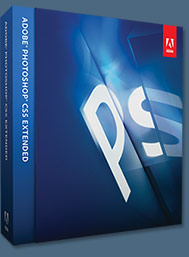 Adobe Photoshop CS5 delivers breakthrough capabilities to help you create images with impact. Refine your
images with reengineered photography tools for removing noise, adding grain, and creating high dynamic
range (HDR) images. Get precise results when making complex selections. Remove any image element and
see the space fill in almost magically. Paint with naturally textured brushstrokes and realistic color blends. Learn more about Photoshop CS5. Adobe Photoshop CS5 delivers breakthrough capabilities to help you create images with impact. Refine your
images with reengineered photography tools for removing noise, adding grain, and creating high dynamic
range (HDR) images. Get precise results when making complex selections. Remove any image element and
see the space fill in almost magically. Paint with naturally textured brushstrokes and realistic color blends. Learn more about Photoshop CS5.
Adobe Photoshop CS5 Extended software helps you create the ultimate images
for print, the web, and video. Enjoy all the state-of-the-art editing, compositing,
and painting capabilities in industry-standard Photoshop CS5, and experience
fast performance thanks to cross-platform 64-bit support. Also create 3D extrusions
for logos, artwork, and motion graphics; edit 3D objects with advanced tools; and create and enhance motion-based content. Learn more about Photoshop CS5 Extended.
Find CS5 upgrade options and Creative Suite 5 deals at the Adobe Store. See CS5 pricing in UK currency at the Adobe UK Store. Visit the Adobe Special Offers page to find the latest deals. Save 80% on Adobe Student Editions. Try before you buy — download a free Photoshop CS5 trial.
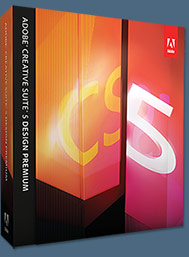 Adobe Creative Suite 5 Design Premium Adobe Creative Suite 5 Design Premium
Adobe Creative Suite 5 Design Premium software gives you fresh new creative tools, along
with the ability to deliver ideas faster in print and create interactive content without writing
code. Plus Design Premium integrates with Adobe CS Live online services to maximize
your design time by streamlining critical nondesign tasks.
Adobe Creative Suite 5 Design Premium combines Adobe InDesign CS5, Photoshop CS5 Extended, Illustrator CS5, Flash CS5 Professional, Dreamweaver CS5, Fireworks CS5, and Acrobat Pro with additional tools and services. Download a free CS5 Design Premium 30 day trial.
Photoshop CS5 Tutorials & CS5 Resources
See our Photoshop CS5 Resource Center for Free Photoshop CS5 Tutorials, and the Free Photoshop CS5 Trial Download. See our Photoshop CS4 Resource Center for Free Photoshop CS4 Tutorials.

Exclusive 15% Discount On All Topaz Plugins - Use Coupon Code PHOTOSHOPSUPPORT - Includes Bundles And Upgrades
 Enter our exclusive discount coupon code PHOTOSHOPSUPPORT during the checkout process at Topaz Labs for an instant 15% discount on any Topaz product, including bundles and upgrades. Enter our exclusive discount coupon code PHOTOSHOPSUPPORT during the checkout process at Topaz Labs for an instant 15% discount on any Topaz product, including bundles and upgrades.
Topaz Labs Photoshop plug-ins are specifically designed to expand a photographer's creative toolbox by harnessing powerful image technology developments. Photographers everywhere are now taking advantage of the creative exposure effects, artistic simplification, unique edge manipulation, and top-of-the-line noise reduction offered in Topaz products. The Topaz Photoshop Plugins Bundle is a super powerful Photoshop plugins package that includes the following Topaz products:
Topaz Adjust
Deliver stunning and dynamic images with this uniquely powerful plug-in that features HDR-like abilities and enhances exposure, color and detail.
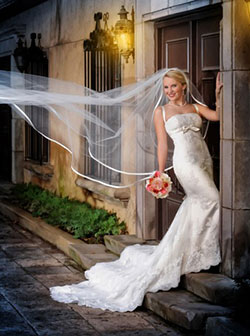 Topaz Detail Topaz Detail
A three-level detail adjustment plug-in that specializes in micro-contrast enhancements and sharpening with no artifacts.
Topaz ReMask
The fastest and most effective masking and extraction program with one-click mask refining.
Topaz DeNoise
Highest-quality noise reduction plug-in that removes the most noise and color noise while preserving the most image detail.
Topaz Simplify
Provides creative simplification, art effects, and line accentuation for easy one-of-a-kind art.
Topaz Clean
Take control of the detail depth of your images with extensive smoothing, texture control and edge enhancement tools.
Topaz DeJPEG
Drastically improves the quality of web images and other compressed photos.
Learn more about the Topaz Photoshop Plugins Bundle. Download a free trial version.

Exclusive onOne Software 15% Instant Discount Coupon
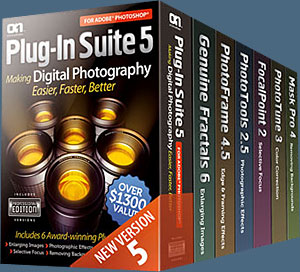 Enter our exclusive discount coupon code - PSSPPT06 - during the checkout process at onOne Software for an instant 15% discount on any onOne product. This includes Genuine Fractals and their amazing Photoshop Plug-In Suite. Enter our exclusive discount coupon code - PSSPPT06 - during the checkout process at onOne Software for an instant 15% discount on any onOne product. This includes Genuine Fractals and their amazing Photoshop Plug-In Suite.
OnOne’s new Plug-In Suite solves six of the most frequent problems photographers will encounter in Photoshop. This suite has been granted American Photos Magazine’s Editor’s Choice award for Top Image Editing Software. The Plugin Suite includes:
Genuine Fractals Pro is renowned by both photographers and printers for its finesse at increasing images to more than ten times their original size while maintaining the sharpness and detail you started with. Think of this as the industry standard for image resizing.
Mask Pro is used to remove the tough stuff — such as hair, smoke and glass — while retaining the fine detail. You choose what colors to keep, then paint away what you don’t need.
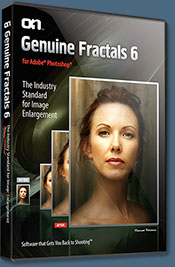 PhotoTools Pro packs hundreds of high-calibre photographic effects into one user-friendly plug-in. It’s fast and easy to use. Gives your photos that pro quality look. PhotoTools Pro packs hundreds of high-calibre photographic effects into one user-friendly plug-in. It’s fast and easy to use. Gives your photos that pro quality look.
PhotoFrame Pro lets you enhance your pictures with hundreds of such design effects, or simply drop your image into a pre-fab layout in Photoshop, Lightroom or Aperture.
FocalPoint helps to control focus and minimize visual noise. Draw the eye to specific points in your images by using selective focus, depth-of-field and vignette effects.
PhotoTune lets you can compare images side-by-side and easily color correct and enhance them. PhotoTune optimizes the dynamic range, color and sharpness of your image without the need to know all the complicated controls in Photoshop like levels and curves.
Simply enter our exclusive discount coupon code - PSSPPT06 - during the checkout process at onOne Software for an instant 15% discount on any onOne product.

Nik Software 15% Instant Discount - Exclusive 15% Coupon
Enter our exclusive discount coupon code - NIKPSS - during the checkout process at Nik Software for an instant 15% discount on any Nik Software product. This exclusive discount coupon code can be applied to all the latest Nik Software Photoshop plugins, including Silver Efex Pro, Color Efex Pro, Viveza, Sharpener Pro, and Dfine.
Color Efex Pro
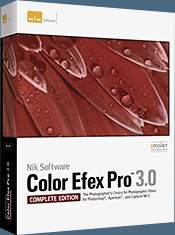 52 photographic filters with over 250 effects for professional quality images.
Completely Original. Completely Indispensable. 52 photographic filters with over 250 effects for professional quality images.
Completely Original. Completely Indispensable.
Nik Software Color Efex Pro filters are the leading photographic filters for digital photography. The award-winning Color Efex Pro filters are widely used by many of today's professional photographers around the world to save time and get professional level results. Whether you choose the Complete Edition, Select Edition, or Standard Edition, you’ll get traditional and stylizing filters that offer virtually endless possibilities to enhance and transform images quickly and easily.
Patented U Point technology provides the ultimate control to selectively apply enhancements without the need for any complicated masks, layers or selections. Control color, light and tonality in your images and create unique enhancements with professional results. With 52 filters and over 250 effects found in Color Efex Pro, you can perform high quality retouching, color correction, and endless creative enhancements to your photographs. Download a free Trial version.
Viveza
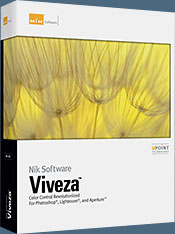 The most powerful tool to selectively control color and light in photographic images without the need for complicated selections or layer masks. The most powerful tool to selectively control color and light in photographic images without the need for complicated selections or layer masks.
Two of the most important factors in creating great photography are color and light. Mastering the art of selectively correcting or enhancing each of these is now possible for every photographer without the need for complicated masks or selections, or expert-level knowledge of Photoshop. Integrating award-winning U Point technology, Viveza is the most powerful and precise tool available to control light and color in photographic images.
U Point powered Color Control Points, placed directly on colors or objects in an image (such as sky, skin, grass, etc.), reveal easy-to-use controls that photographers can use to quickly adjust brightness, contrast or color in a fraction of the time needed by other tools. With Viveza you’ll spend more time shooting photographs and save hours of image editing. Download a free Trial version.
Silver Efex Pro
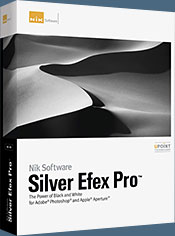 Complete power and control to create professional quality black and white images in one convenient tool. Complete power and control to create professional quality black and white images in one convenient tool.
Silver Efex Pro from Nik Software is the most powerful tool for creating professional quality black and white images from your photographs. For the first time, all the advanced power and control required for professional results have been brought together in one convenient tool.
Featuring Nik Software’s patented U Point technology to selectively control the tonality and contrast of the image, Silver Efex Pro includes advanced imaging algorithms to protect against unwanted artifacts, a comprehensive collection of emulated black and white film types, a variable toning selector for adding traditional toning techniques, over 20 one-click preset styles, and a state-of-the-art grain reproduction engine that help produce the highest quality black and white images possible from your color images while providing more freedom to experiment. Download a free Trial version to use Silver Efex Pro.
Enter our exclusive discount coupon code - NIKPSS - during the checkout process at Nik Software for an instant 15% discount. This exclusive discount coupon code can be applied to all the latest Nik Software Photoshop plugins, including Silver Efex Pro, Color Efex Pro, Viveza, Sharpener Pro, and Dfine.

Photoshop Masking Plugin Fluid Mask - Exclusive Instant Discount
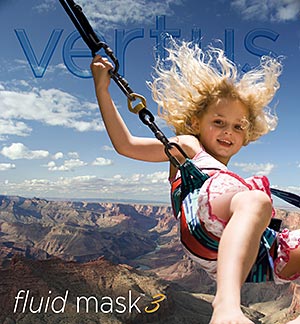 The 4 1/2 out of 5 star review of Fluid Mask at MacWorld begins by saying that this "Photoshop plug-in takes the pain out of extracting backgrounds," and goes on to recommend the latest version, stating that "Fluid Mask is a very effective tool for separating objects from their backgrounds. It offers a variety of useful features for tackling almost any difficult image, from wispy hair to complex foliage. Online video tutorials and live training sessions help ease the learning curve." The 4 1/2 out of 5 star review of Fluid Mask at MacWorld begins by saying that this "Photoshop plug-in takes the pain out of extracting backgrounds," and goes on to recommend the latest version, stating that "Fluid Mask is a very effective tool for separating objects from their backgrounds. It offers a variety of useful features for tackling almost any difficult image, from wispy hair to complex foliage. Online video tutorials and live training sessions help ease the learning curve."
Our friends at Vertus, the makers of Fluid Mask Photoshop Plugin, have set up a special exclusive discount for PhotoshopSupport.com. Go to our Fluid Mask page for a special, exclusive discount link.
Fluid Mask is designed for photographers, image editors, graphic designers and all those who take digital image editing seriously. In a streamlined interface and workflow, Fluid Mask instantly shows key edges in the image and provides comprehensive easy to use tools that work with difficult-to-see edges and tricky areas like trees & lattices. Fluid Mask will also preserve all-important edge information for a professional quality cut out. Go to our Fluid Mask page for more info.

lynda.com Online Training Library - View Free Video Clips
 Subscriptions to the lynda.com Online Training Library provide anytime access to tens of thousands of video tutorials covering Photoshop, Illustrator, Dreamweaver, web design, digital imaging, 3D, digital video, animation, and many other topics. View free video clips. Subscriptions to the lynda.com Online Training Library provide anytime access to tens of thousands of video tutorials covering Photoshop, Illustrator, Dreamweaver, web design, digital imaging, 3D, digital video, animation, and many other topics. View free video clips.
For less than a dollar a day, members have the opportunity to stay current and keep skills sharp, learn innovative and productive techniques, and gain confidence and marketability - all at their own pace. Premium subscriptions include instructors’ exercise files so that members can follow along with the exact examples onscreen. Customers learn at their own pace and may stop, rewind, and replay segments as often as necessary. View some free video clips (high resolution).

Did You Know You Could Create An Entire Website In Photoshop?
SiteGrinder Photoshop Plugin - Create Websites Instantly
 There often seems to be a strict division of labor within the world of web design and development. Creative professionals tend to stick to the Photoshop domain, while those well-versed in scripting are left to the task of implementing their work. Indeed, the two realms are quite different from each other, to which any of us even vaguely familiar with either can easily attest. There often seems to be a strict division of labor within the world of web design and development. Creative professionals tend to stick to the Photoshop domain, while those well-versed in scripting are left to the task of implementing their work. Indeed, the two realms are quite different from each other, to which any of us even vaguely familiar with either can easily attest.
Essentially, Photoshop is a no-holds-barred design studio, offering the artist a seemingly endless array of creative options. On the other hand, HTML, CSS, Java and the like follow strict rules of engagement, requiring the developer to take any number of esoteric concerns into consideration in order to ensure that designs are properly displayed on the web.
Turn Photoshop Into A Complete Web Design Tool
SiteGrinder seeks to bridge this gap between design and development. Basically, SiteGrinder turns Photoshop into an easy-to-use and fully functional web design tool. With SiteGrinder, designers will now have the freedom to totally let their creativity loose and then, without skipping a beat, transfer their designs to the web. Bringing esthetic concerns together with more practical considerations, SiteGrinder is an amazingly powerful tool that would make a fantastic addition to any web designer's bag of tricks. Mac OS X and Windows versions of the SiteGrinder unlockable demo are available now via download.

Photoshop CS4 Essential Skills - By Mark Galer And Philip Andrews
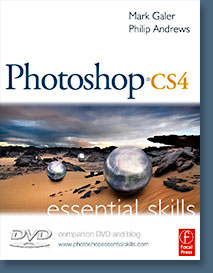 Brimming with beautiful pictures, Photoshop CS4 Essential Skills guides you through a project-based, progressive curriculum so that you can build all the essential skills to enhance photographs creatively and professionally with Photoshop CS4. If you are an aspiring professional or a student learning photography, digital imaging, or design graphics, you'll be amazed at the stunning results you can achieve. A DVD is included free. Brimming with beautiful pictures, Photoshop CS4 Essential Skills guides you through a project-based, progressive curriculum so that you can build all the essential skills to enhance photographs creatively and professionally with Photoshop CS4. If you are an aspiring professional or a student learning photography, digital imaging, or design graphics, you'll be amazed at the stunning results you can achieve. A DVD is included free.
The Essential Skills Photography Series from Focal Press uniquely offers a structured learning experience for photographers of all ages, with both the underlying theory and loads of invaluable 'how to' and real-life practice projects - all from the most talented photography practitioners/educators in the world.
Read 2 free sample chapters:
Skin Retouching Tips In Photoshop CS4
Transforming Smart Objects In Photoshop CS4
Find more Photoshop CS4 tutorials on our Photoshop CS4 Tutorials Page.
Read 2 free sample chapters from the Adobe Photoshop CS3 version:
Adjusting Exposure in Adobe Camera Raw CS3
Photoshop CS3 Tutorial High Dynamic Range
Find More Adobe Photoshop Books at Amazon.com
Find all the latest bestselling Photoshop books at discount prices at Amazon.com.




|
|
|
![]()
![]()
![]()
![]()
 Selections can be created in a number of ways. They can be created from the ground up using the selection marquee or lasso tools, or with painting tools by entering Quick Mask mode, or they can be based on the luminosity or the color data in the image. They can also be created from existing paths and path components. In ImageReady, you can create selections from slices.
Selections can be created in a number of ways. They can be created from the ground up using the selection marquee or lasso tools, or with painting tools by entering Quick Mask mode, or they can be based on the luminosity or the color data in the image. They can also be created from existing paths and path components. In ImageReady, you can create selections from slices.

